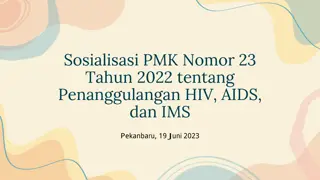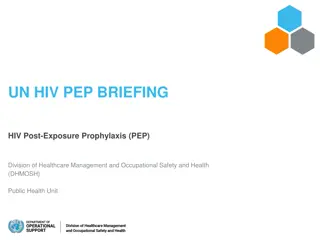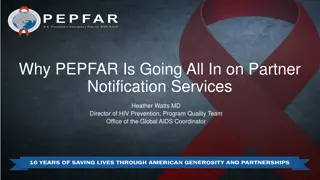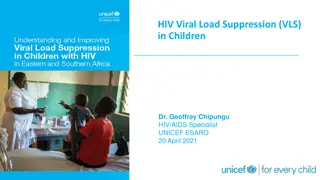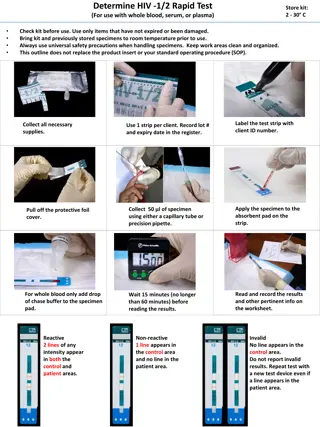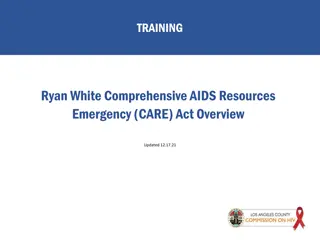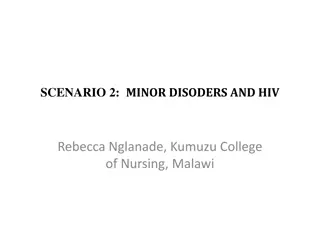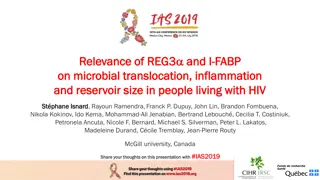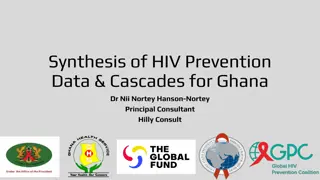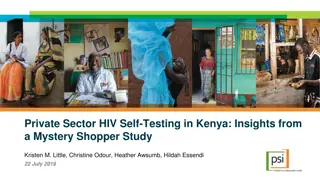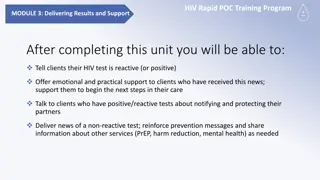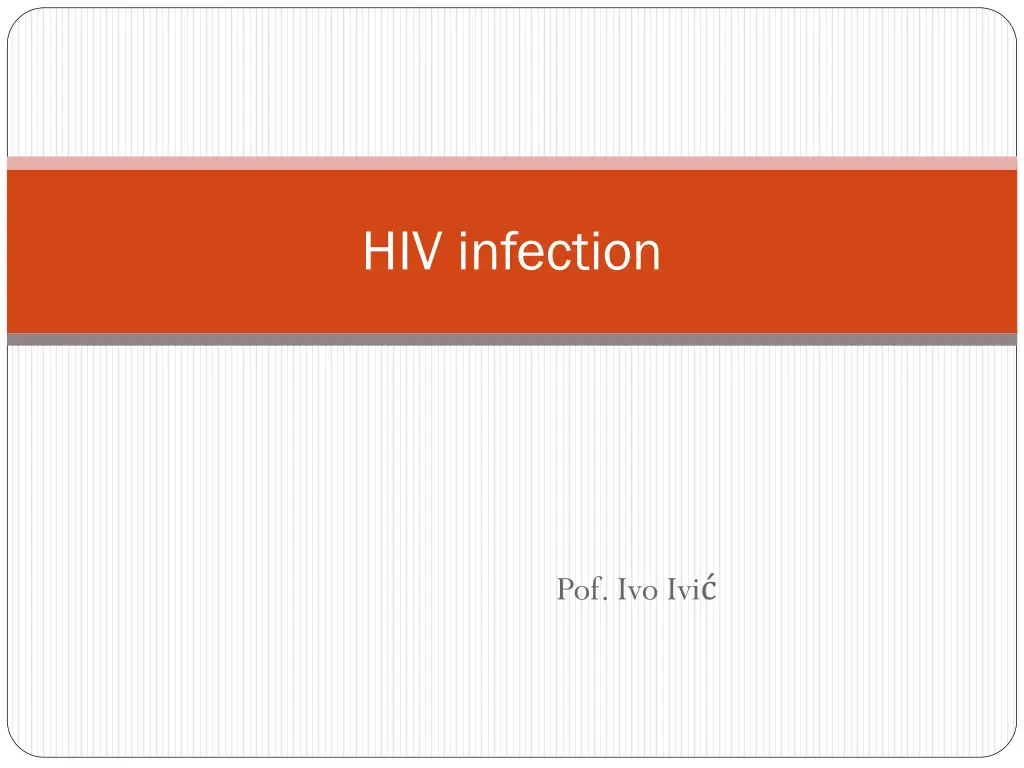
Understanding HIV Infection and Epidemiology in Croatia
Explore the epidemiology of HIV infection in Croatia, including statistics on the number of cases, deaths, and new infections. Learn about the routes and risks of HIV transmission, as well as preventative measures to reduce the risk of infection. Delve into the pathogenesis of HIV, from viral binding to lymphocyte infection and replication, leading to the development of acute retroviral syndrome. Gain insights into the immune response and clinical latency phase of HIV infection.
Download Presentation

Please find below an Image/Link to download the presentation.
The content on the website is provided AS IS for your information and personal use only. It may not be sold, licensed, or shared on other websites without obtaining consent from the author. If you encounter any issues during the download, it is possible that the publisher has removed the file from their server.
You are allowed to download the files provided on this website for personal or commercial use, subject to the condition that they are used lawfully. All files are the property of their respective owners.
The content on the website is provided AS IS for your information and personal use only. It may not be sold, licensed, or shared on other websites without obtaining consent from the author.
E N D
Presentation Transcript
HIV infection Pof. Ivo Ivi
Croatia -1300 persons with HIV(2015) -190 died 80 new cases/year 20 new cas./1 mil/year Other EU countries: 57 new cas./mil/year
Route and risk of infection Blood transfusinon = 100 % Child born from untreated mother = 30% Nidle-stic injury from HIV + = 1:300 Sexual (rectal =vaginal): High viremia: 1% per intercourse Low viremia: < 0,01% per intercourse Repeated exposure : 1% per month Gental ulcers increase risk by10 times Kissing ?! = 0% HIV in not present in saliva
What decreases risk of infection? Condoms (almost 100% reduction) Blood supply control 1infection/0,5 mil transfusions = 0,000005% Therapy of mother: risk for child <1% Sterile needles (needle stick exchange) in IVU: 90% reduction
Pathogenesis Viral gp120 binds to DC-SIGN of dendritic cells (DC) Attachment to CD4 (lymphocytotophic virus) and CCR5 receptors (monocytotrophic virus)
Pathogenesis Pathogenesis- -continued continued HIV crosses mucosa, Transport by dendritic cells (Trojan horse) into the lymph nodes Infection of T lymphocyte in the lymphnodes Replication and release of HIV, Infection of new lyphocytes- rise of viremia (millions/ml) Dissemination of the virus in other organs After 2-3 weeks of incubation Acute retroviral syndrome
Pathogenesis Pathogenesis- -continued continued
Pathogenesis Pathogenesis- -continued continued 2-4-weeks after acute retroviral sy. Immune response awakes Antibodies + Specific cytotoxic T cells appear Tansient control of HIV replication is established Drop of viremia to plato level av. 30.0000 copies/mL the higher plato level = the shorter duration of control Clinical latency
Pathogenesis Pathogenesis- -continued continued
Pathogenesis Pathogenesis- -continued continued After latent period CD4 cell count drop progressively HIV replication inceases exponentially CD4 cel count < 200/ml Opportunistic infections (AIDS)
The rate of disease progression Years to symptomatic infections (CD4 <200/mL) Type of progression 1. Typical 2. Rapid 3. Slow 4. Long-term non-progressors 8-10 y 1-2 y >10 y virtually never
Progression inversely correlates with viral load plateau: the lower is viral load = the better is cytotoxicT-ly response
Factors influencing progression of HIV infection Generaly not well understood Age: Fetal infection . more rapid progression Younger adult age slower progression Older adult age more rapid progression
Acute HIV infection Clinical feature
Asymptomatic early infection Peristent generalised lymphadenopathyPGL Acute HIV syndrome
PGL- peristent generalised lymphadenopathy Afebrile Enlarged lymph nodes in 2 areas Lymph node diamenter 1cm No other etiology confirmed
Acute HIV syndrome (tansient symptomatic disease) Fever with: 1. no other symptoms = flu like disesase; or 2. . rash; or 3. oral and genital ulcers; or 4. pharyngitis, or 5. lymphadenopathy = inf.mononucleosis sy.; or 6. .. . headake - aseptic meningitis
Pink-to-red macules or maculopapules: trunk, neck, face Painful oral and genital ulcers Symptoms resolve within 2 weeks Lethargy and fatigue may perisit for months
LABORATORY Leucocyte count: normal or slightly below normal Liver transminases: moderately elevated CSF (if positive): viral meningitis profile
Symptomatic HIV infection Acquired Immune Deficiency Syndrome (AIDS)
https://encrypted-tbn0.gstatic.com/images?q=tbn:ANd9GcR9V-rRiheFM_pAO_75aS5WpXSSB0cLGi-YGpzkBg8gZxDvtJHchttps://encrypted-tbn0.gstatic.com/images?q=tbn:ANd9GcR9V-rRiheFM_pAO_75aS5WpXSSB0cLGi-YGpzkBg8gZxDvtJHc Cytotoxicity (CD8) Antibody production (B cells) https://encrypted-tbn1.gstatic.com/images?q=tbn:ANd9GcRKA8vUdldcrOj5r_GZFQIFFWtw1mMr_NlEcBKIHAzC0fY8Tj3- http://upload.wikimedia.org/wikipedia/commons/d/df/T-dependent_B_cell_activation.png CD4 -T helper-
Decreased CD4 cell count Critical = 200 /mL Exogenous infections: repeated and prologed S.penumoniae, non-typhiod Samonella Reactivation of latent infections Infections caused by opportunistic pathognes Developement of malignancies
Reactivation Reactivation of of latent Infections Infections caused caused by latent infections infections by opportunistic opportunistic pathognes pathognes Bacterial: Mycobacterium tbc, atypical mycobacteria (MAC) Fungal: Candida, Pneumocystis j., Crypotococcus, Histoplasma Viral: CMV, HSV, VZV, EBV,HHV, poliomaJCV* Protozal : Toxoplasma g., Cryptosporidium, Isospora belli Roundworm: Strongyloides stercoralis * JCV (John Cunningham virus)
Indicator Indicator diseas diseas of of AIDS AIDS in in adults adults Bacterial infections Recurrent bacterial pnemonia ( 2 episodes/1 month) Recurrent Salmonella septicema or prolonged diarrhoea Pulmonary/extrapulmonary tuberculois Disseminated Mycobacterium avium Nocardiosis
Indicator Indicator conditions conditions of of AIDS AIDS in in adults adults- - continued continued Fungal infections Candidiasis: oesophagus, trachea, lungs Pneumocystis jiroveci pneumonia Cryptococcosis: extrapulmonary (CNS) Extrapulmonary histoplasmosis
Candidiasis https://encrypted-tbn1.gstatic.com/images?q=tbn:ANd9GcQPHIcjgSUA18d1Nd0EWozxCnjTjZcHRpbybrjEUwhHlYbssBeB Oral https://encrypted-tbn3.gstatic.com/images?q=tbn:ANd9GcTM_gJlmqR8oJijPv5kJkB8zbBA5v2ooJInJAwzXApzDkgcNeGg https://encrypted-tbn0.gstatic.com/images?q=tbn:ANd9GcR0zq07sBchkHHaDajUdNIEZDXioYCUuEhzjaMqcnY2JdLlzytdZg Esophageal Respiratory
Pneumocystis jiroveci https://encrypted-tbn3.gstatic.com/images?q=tbn:ANd9GcTnMVox-DeogGWuv-dJ3F4ajzP0W9_Slzkd3Xd4wo1rjZJYvSwZ SatO2 LDH
Indicator Indicator conditions conditions of of AIDS AIDS in in adults adults- - continued continued Viral infections HSV: mucocutaneous ulcerations Lasting for more than 1 month CMV: colitis, penumonia, etc. (ly.nodes, spleen, liver and eye- excluded) JC V (John Cunninham virus) : progressive multifocal leucoencephalopathy (PML)
https://encrypted-tbn0.gstatic.com/images?q=tbn:ANd9GcTbTHxKsAEVDwsQaR3zuLtYvk3PKYFcnIWTX7qc-CO2Ce0h5m4Uhttps://encrypted-tbn0.gstatic.com/images?q=tbn:ANd9GcTbTHxKsAEVDwsQaR3zuLtYvk3PKYFcnIWTX7qc-CO2Ce0h5m4U https://encrypted-tbn1.gstatic.com/images?q=tbn:ANd9GcRPnwi3Z6sdEJqUy_AkHk8o4UEthHkjjFlb6C9lPrNXD429rCk- Genital HSV ulcerations CMV ulcerative colitis https://encrypted-tbn2.gstatic.com/images?q=tbn:ANd9GcTmkEA5zVH2c5U2EDOT1CMSjJxy8HMgtUgDzISEVtDq1fqbzBlGrA Oral HSV ulcerations
Indicator Indicator conditions conditions of of AIDS AIDS in in adults adults- - continued continued Protozal infectios Cryptosporidosis: diarrhoea for more than 1 month Toxoplasmosis of internal organs (CNS) Roundworm infection Extraintestinal stongyloidiasis
Indicator Indicator conditions conditions of of AIDS AIDS in in adults adults- - continued continued http://www.theaidsreader.com/sites/default/files/resize/aidsreader/1390115-500x624.png Progressive multifocal leucoencephalopathy (PML) JCV White matter inflammation Demyelinating disase
https://encrypted-tbn0.gstatic.com/images?q=tbn:ANd9GcTbPtMNm90I09nV7NRN2GVNjVO9KG4-0t9BfJcVop3lWbl5AGhznAhttps://encrypted-tbn0.gstatic.com/images?q=tbn:ANd9GcTbPtMNm90I09nV7NRN2GVNjVO9KG4-0t9BfJcVop3lWbl5AGhznA CNS toxoplasmosis https://encrypted-tbn2.gstatic.com/images?q=tbn:ANd9GcQcbEDAp2kgZbZColcB9lfCacMfA6uWexa-fS28EglSJv9J8gtD Extraintestinal stongyloidiasis sepigonus subcutaneous infiltates
Indicator Indicator conditions conditions of of AIDS AIDS in in adults adults- - continued continued HIV-associated wasting : Involuntary loss of >10% of weight + Chronic diarrhoea (more than 1 month) or chronic wekness + Prolonged enigmatic fever (more than 1 month). HIV-associted dementia Loos of cognitive functions
Developement Developement of of malignancies malignancies Virus HHV-8 EBV ; HHV-8 Kaposi sarcoma Non-Hodgkin B-cell lymphoma (systemic and CNS) Invasive cervical carcinoma HPV Leiomyosarcoma (pediatric) Hepatocellular carcinoma Hodgkin disease Anal cancer EBV HCV, HBV EBV HPV
Caposi sarcoma https://encrypted-tbn3.gstatic.com/images?q=tbn:ANd9GcShHWpX7NV5uNjmQ8awKc0ZTeabP_CuRfPn0l4k_52-f0Lv79tM Oral https://encrypted-tbn3.gstatic.com/images?q=tbn:ANd9GcTnS3TbE4R3B24LtBAcQdns4TDPOqbfTJl9Rrgr5r_z8yceIOCD brownish skin infiltrates https://encrypted-tbn2.gstatic.com/images?q=tbn:ANd9GcQsciIIXJuYsJyS7MVU5U5wZ4brPXUYgyMcs4CsxXq0YW5KYiUp brown to dark purple tumors Intestinal
Non-hodgkin B cell lymphoma (neck) CNS B cell lymphoma (unilocular)
Testing for HIV anti-HIV: antibodies to envelope glycpoprotein gp120 99% sensitive and specific window period 18-24 days 95% become positive witnih 90 days determined by 3rdand 4thgeneration ELISA HIV Ag: protein p24 detectable in early (acute) infection 4thgeneration ELISA PCR HIV-1 nucleic acids
4thgeneration ELISA- remcomended Detection of p24Ag + anti-gp120 Ab Confirmation with the same 4thgen.test 3rdgeneration ELISA Detection of anti-gp120 Ab Confirmation with Western blot is recquired
PCR HIV-1 1. Qualitiative (+ or -) detection of revresely transcribed DNA (in CD4+cells) useful in ELISA (anti-HIV) negative windov period 2. Qunatitative (number of copies/ml) detection of viral RNA in plasma used to determine level of viremia
Target sites of action of antiretoviral therapy (ART) 1stline HAART
Nucleoside Reverse Transcriptase Inhibitors Non Nucleoside Reverse Transcriptase Inhibitors Protease Inhibotors Entry inhibotor
HAART HAART- -Higly Higly Active Active ART ART Combination of at least 3 drugs: First line: 2 NRTI + 1 PI (or 1 NNRTI) Why HAART? High rate of replication of HIV Rapid development of resistence with monotherapy Tretment goal Maintenace of HIV RNA copies below 50/mL (the best prevention of drug resistence ) Lifelong therapy reqiured
When to start therapy? Should be guided by the number of CD4: CD4 count below 350/mL- strongly reccomanded CD4 count 350-500/mL- moderately reccomanded CD4 count above 500/mL- optional ie: high level od HIV RNA (rapid progressor)

